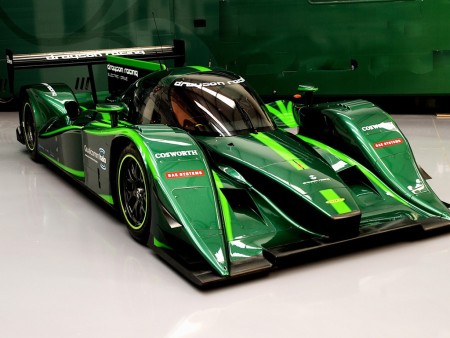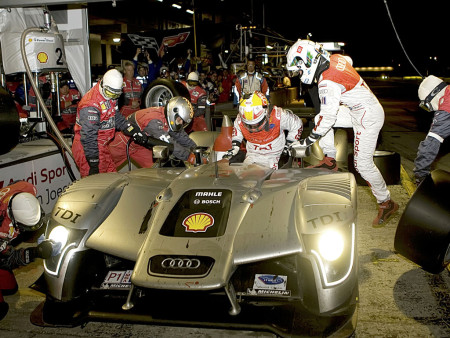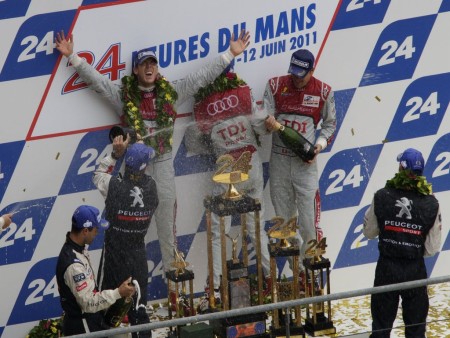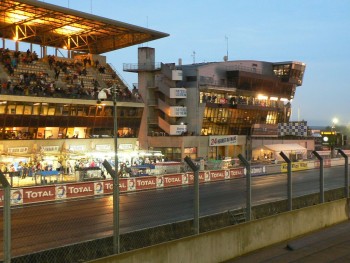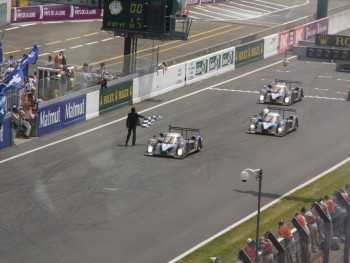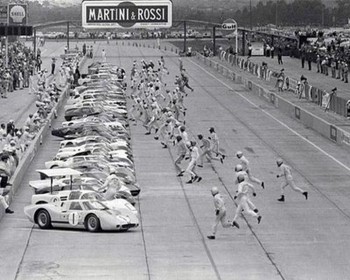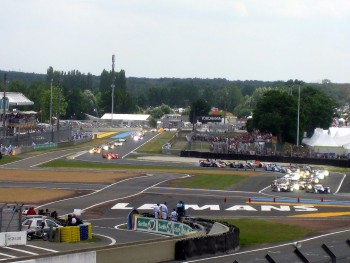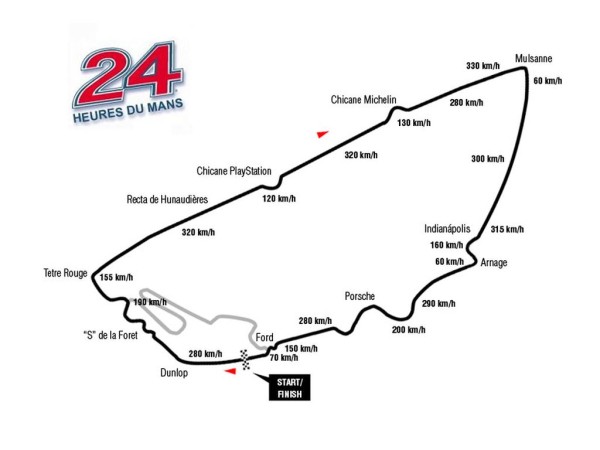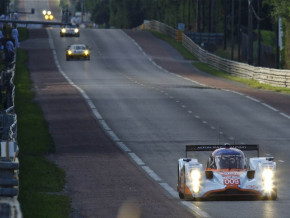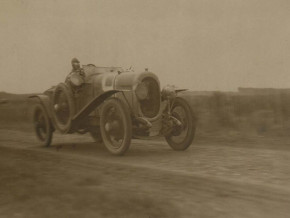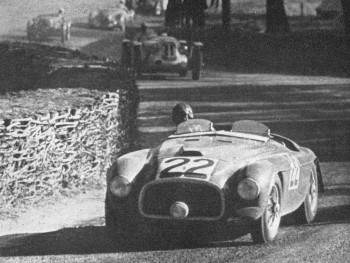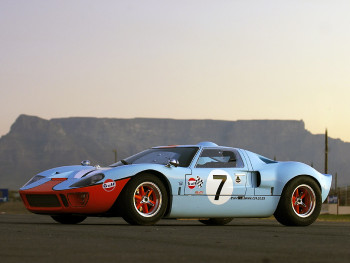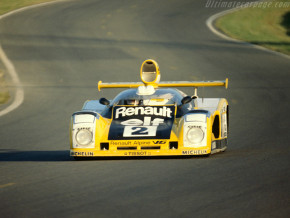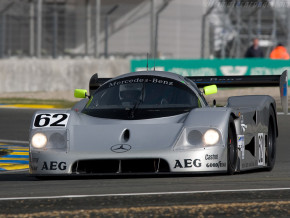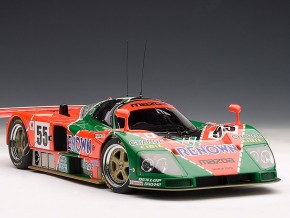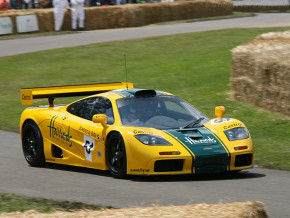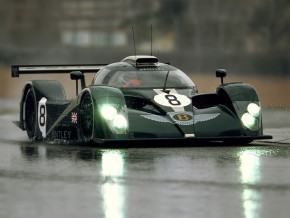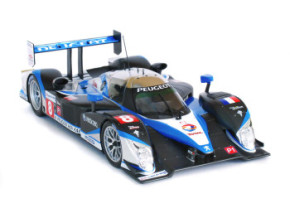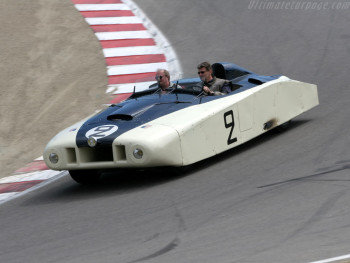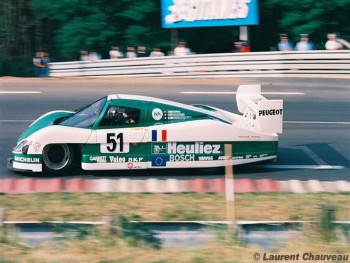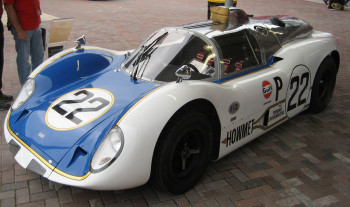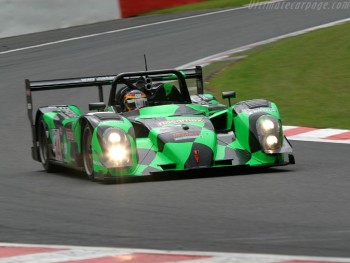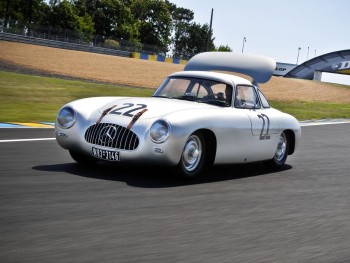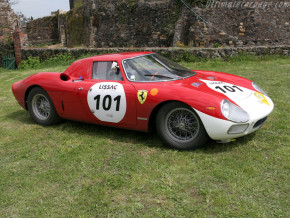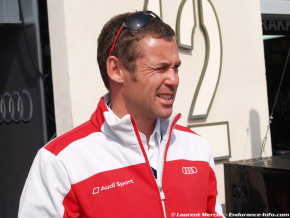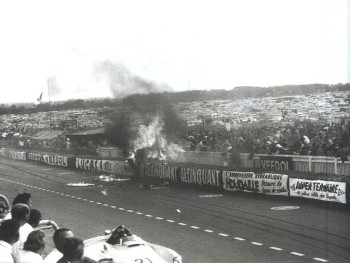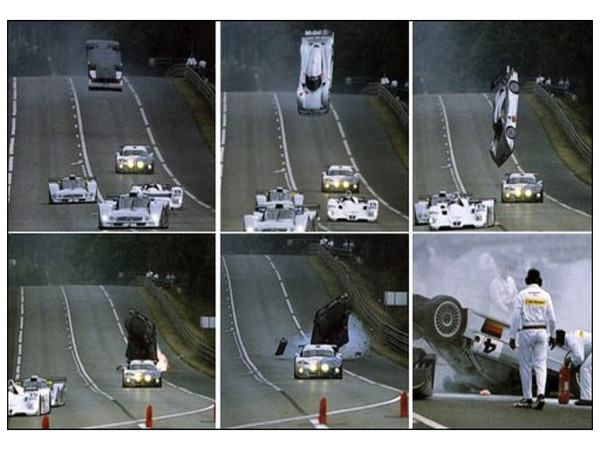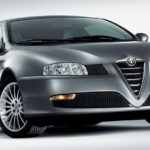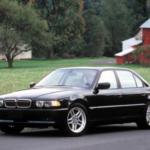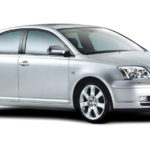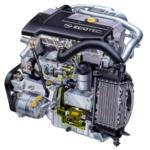24 Hours of Le Mans
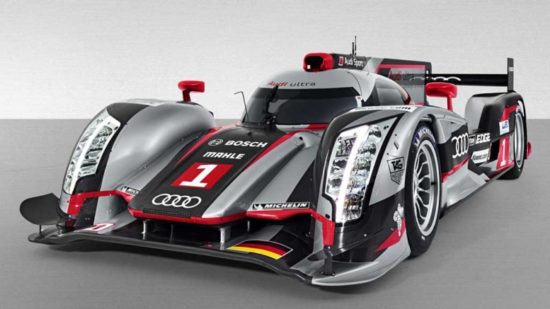
24 Hours of Le Mans
The 24 Hours of Le Mans Endurance Race is the world's oldest active car racing endurance race, held annually starting in 24 near the French city Le Mans. It is also known as the Endurance and Efficiency Grand Prix.
The teams involved in the race must balance speed with the car's ability to drive for 24 hours regardless of mechanical damage to the car, and cleverly take care of consumables and car parts, notably fuel, tires and brake materials.
Driver endurance is also tested during the race, as drivers often spend more than two hours behind the wheel before the mandatory stop in their garages (pit stops) for regular service (pitstop), allowing for replacement with a new rest driver who takes over driving responsibilities. The tired drivers then take their food and drink and rest before returning to the wheel again. Today, it is a rule that three drivers from the same team share one competing car.
The competition is organized by the Automobile Club de l'Ouest (ACO) and takes place at the Circuit de la Sarthe, which consists of a mixture of closed public roads and a specialized race track designed not only to test the car and driving ability to be fast, but to all it lasts for a 24 hour period. Competitive teams (teams) drive in certain, separate classes for cars of similar specifications while at the same time competing with all other participants among all classes.
Originally, the race was held only for free-selling cars, which were then called Sport Cars in relation to special race cars used in Grand Prix competitions. Over time, competing vehicles have evolved away from their true road vehicle roots, so today the competition consists of two classes of specialized two-seater closed body vehicles such as Prototype Sport Car and two classes of Grand Touring cars that have much more similarities to high-performance cars. which are marketed. Competition teams have different forms of organization ranging from the racing department of carmakers who are eager to prove the superiority of their products, through professional racing teams representing their commercial supporters, some of whom are also carmakers trying to win regardless of team composition, to amateur teams. racing teams competing as much to win the famous race as much as to win their business partners (sponsors).
The race takes place at the beginning of the summer in the month of June, leading to sometimes very hot weather for drivers, especially in closed vehicles whose cab can be heated to uncomfortably high temperatures because they have poor ventilation. Rain, however, is not uncommon at this time of year. The race starts in the middle of the afternoon, lasts through the night and the morning before the end, the next day, at the same time as the race started. In 24 hours, the most modern and sophisticated competitors will travel over 5.000 kilometers. The current record is 5.410 km in the 2010 race. That's a distance that is over six times longer than the Indianapolis 500 race distance, or about 18 times longer than the average length of a Formula One Grand Prix race. The race has inspired the existence of similar races around the world over the years, popularizing the 24-hour race format in places like Daytona, Nurburgring, Spa-Francorchamps, Sebring and Mount Panorama. Currently, the American Le Mans Series and the European Le Mans Series as multi-sport events are excluded from the 24 Hours of Le Mans regulations. Other races at Le Mans include the Le Mans Classic, the Le Mans Historic Race Car Race of the Past held annually at the Circuit de la Sarthe, the motorcycle race run on the shortened Bugatti Trail, the 24 Heures Karting Kart and the Truck Race 24 Heures Camions. This race was for a period of time one of the races from the World Sportscar Championship, although Le Mans has always had a greater reputation than other similar races, and is currently one of the races from the FIA World Endurance Championship. The race is also known as one of three informal races to win the so-called. The Triple Crown of Motorsport that connects Formula One, IndyCars and Sports Car racing cars to the greatest career success of any sports driver. In addition, this manifestation forms part of the so-called. Triple Crown of Endurance Racing linking this to two other major endurance racing cars, 12 Hours of Sebring and 24 Hours of Daytona, USA.
The meaning of the race
At a time when Grand Prix racing dominated motorcycling across Europe, Le Mans was designed to represent a different racing world. Instead of focusing on the ability of one company to make the fastest car, this race focuses on the ability of manufacturers to elevate sports performance and further enhance the reliability of the car. This encourages innovation in production and reliable fuel-efficient vehicles, because the nature of endurance racing requires cars that cross long distances and spend little time in their garages if possible. At the same time, the configuration of the track creates the need for cars that have the best aerodynamics and stability at high speeds. While this is also the meaning of a Grand Prix race, several highways in Europe have long routes comparable to the famous Mulsanne route in Le Mans. The fact that it is a public road that is not maintained in the same quality way as race tracks puts even more emphasis on the reliability of competing cars.
The need for fuel economy created during the oil crisis of the early 1970s prompted race organizers to adopt the Group C fuel economy formula in which each car receives the limited amount of fuel it is allowed to use during the race. Although Group C was abandoned when teams were able to master the fuel economy formula, fuel economy is still important, so some teams began using alternative fuels in the early XNUMXst century trying to shorten the time spent in boxing for service. These technological innovations have a positive effect, as the technology used at Le Mans is finding its way into the production of serial cars after several years. This also led to the creation of more so-called Supercars from manufacturers who want to develop fast cars to further their development into even faster GT cars.
Le Mans is racing
Cars
The usual total number of vehicles registered for a race is a maximum of 50. Each car must have at least two seats, although in the last few years there are vehicles with only the possibility of placing another seat in the cockpit while it is not actually present. Cars with more than two doors are not allowed. Open cockpit cars do not require a door. Although all cars start competing at the same time there are separate competing groups (classes). The prize is awarded to the winner of each class as well as the overall winner. The number of classes has varied over the years, but there are currently four basic ones. Dedicated Le Mans Prototypes (LMP) are a best-in-class class with two individual top classes, LMP1 and LMP2, divided by speed, weight and power.
As of 2011, the next two classes consist of Grand Tourer (GT) -based vehicles, GT Endurance Pro and GT Endurance AM. These two classes use FIA GT2 class vehicles. Although the most likely winner is a LMP best-class car, lower-class vehicles occasionally win victories for better reliability.
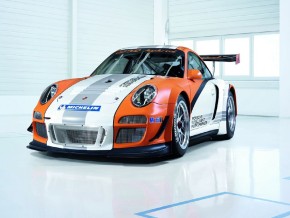
Drivers (competitors)
Originally, there was no rule about the number of drivers in one car or how long they could drive continuously. Although almost all teams used two drivers in the early decades of the race, some Le Mans drivers such as Pierre Levegh and Eddie Hall tried to take the entire race on their own in hopes of saving time by not having to change drivers. This practice was later banned. By the 1980s, there were teams with only two drivers competing, but by the end of the decade, the rules had been changed to allow at least three drivers to drive one car. By the 1990s, given the speed of cars and the pressure on drivers, new rules were added to improve driver safety. Drivers may not drive consecutively for more than four hours and no driver may drive more than fourteen hours in total. This reduces the extreme psycho-physical fatigue of the driver during the race.
Unique rules and tradition
While this race has been part of the World Sportscar Championship for a long time, it has regularly had rules that differ from those used in other racing series in part because of the length of the event itself. Some rules are established for security reasons, while others are related to the competition itself. For the past several decades, cars have had to stay at least one hour in the race before being allowed to refill car fluids such as oils or coolants with the exception of fuel. This was an attempt by the ACO to contribute to increasing efficiency and reliability.
A car that cannot withstand the first hour of a race without having to replace the fluid consumed is disqualified. The second rule is unique to the Le Mans race, which is the condition that the car be completely switched off (extinguished) as long as new fuel is poured into the tank. This is important not only for the idea of greater safety and reduced fire conditions, but also allows for a second reliability test as vehicles thus test their ability to restart (ignition) multiple times during the race. Another element of this rule is that mechanics are not allowed to work on a car or its tires as long as new fuel is being poured, which has led teams to apply innovative ways to reduce the time of long stops in boxing. As an exception to this rule, a driver can get out of the car and be replaced by another driver during refueling.
There are different traditions at Le Mans. One of the longest is waving a French national tricolor to mark the start of the race. This is usually after the flight of planes over Le Mans emitting blue, white and red smoke in the colors of the French flag. A similar tradition involves waving all flag flags by the judges next to the runway during the last lap of the race, which is so congratulating the winners and all other riders. The celebratory splash of champagne is also known in this race by the winning rider celebrating the victory instead of drinking it. When Dan Gurney won the race in 1967 with co-driver AJ Foyt, two drivers climbed the podium and Gurney was splashed with champagne. Looking down he saw the CEO of the company Ford, Henry Ford II, owner of the Carroll Shelby team and their wife, as well as several journalists who predicted disaster in the race for the winning duo. Gurney shook a bottle of champagne and sprayed it all around, establishing a winning tradition re-enacted for the next 40+ years. Gurney, however, gives an autograph bottle of champagne to LIFE photographer Flip Schulke, who used it many years later as a lamp. He did, however, recently return the same bottle to Gurney who now holds it at his home in California.
Racing program
The first 24 Hours of Le Mans race was held May 26-27, 1923 and has since been ridden every year in June with the exceptions of 1956 when the race was held in July and 1968 when it was held in September due to national political turmoil in France. The race was canceled twice: once in 1936 because of the workers' strike during the Great Crisis, and from 1940 to 1948 because of World War II and its aftermath. The race takes place over the weekend, usually on the second weekend of June, with qualifications and rehearsals taking place on the Wednesday and Thursday before the race following the administrative and technical inspection of the car on Monday and Tuesday. Currently, these sessions are held in the evenings as two separate two-hour sessions each night. The holiday day is scheduled for Friday, and includes a parade of all drivers and cars through downtown Le Mans.
Test days are usually held before the event itself, traditionally in late April or early May. These tests serve as pre-qualifications for a race where the slowest cars are not allowed to reappear in official qualifications. However, due to the cost necessary to transport the cars to Le Mans and their return back to their competition series between testing and racing week, Test Day has been moved to the first weekend of June since 2005.
The pre-qualification system was discarded in 2000 after all competitors invited to the test were allowed to participate in the race. The Le Mans Legend race has also been a part of the program since 2001 and usually takes place with a follow-up exhibition of old cars during the qualifying day a few hours before the introduction of Le Mans participants. By 2008, the race began at 16:00 pm on Saturday, although in 1968 the race began at 14:00 pm due to a delay in the race calendar. In two cases, in 1984 and 2007, the start of the race was postponed by 15:00 owing to clashes in the French presidential election. In 2006, the ACO scheduled a 17pm start on Saturday 00 June to increase television coverage of the FIFA World Cup Finals. Since 17, the race has been taking place from 2009 to 13 June starting at 14:15 local time (00:13 GMT) and will start at exactly that time.
Qualifications
Originally, race results were determined by the distance traveled by each competitor. A car of any class that crosses the greatest distance (mileage) is declared the winner. This became accepted because of Ford's 1966 team victory. With a dominant 1-2 lead, both vehicles slowed to take a picture at the finish line with Denny Hulme just ahead of Bruce McLaren. However, since McLaren's car actually started well behind Hulme, McLaren's car actually traveled the longest distance in 24 hours. With a winning margin of just eight meters, McLaren and his co-driver Cris Amon were declared the winners. Not only did this decision lead Hulme to victory, he also denied his co-driver Ken Miles, who had already won two other Sebring and Dayton endurance races. With the victory at Le Mans he would become the first man to win all three of the most significant endurance races in the same year. Miles was one of the oldest racers on the track. He was tragically killed in a car accident later that year. The rule of maximum distance traveled was later changed when the so called Rolling start, so now the winner is the car that has completed the largest number of entire laps in the race.
In order to qualify for the official race results, the car is required to cross the finish line after 24 hours. This has led to dramatic scenes where damaged cars wait for hours in garages or at the edge of the track near the finish line, then restart their engines and crawl across the finish line to find their official results. However, this waiting practice has been banned in the last few years by the decision that teams that cross a certain distance in the last hour will be classified as having completed the race. Another rule instituted by the ACO was the requirement for a car to exceed 70 percent of the rounds achieved by the overall winner. If a car fails to exceed this number of laps, even if it does finish the race, it is not considered worthy of classification due to its poor reliability or low speed.
Le Mans start
The race traditionally begins with what has become known as the Le Mans start in which cars are lined up with so-called. Pit wall in the order in which they are qualified. The first drivers stand on the opposite side of the runway in front of the car. When the French flag is marked as the start, drivers cross the track to their cars, enter them, and start the vehicle unassisted. This became a major safety issue in the late 1960s when motorists began to ignore certain safety rules that were introduced in the meantime. This led drivers to use the first few laps of the race to illicitly harness start-ups with anticipated opponent errors and overtake them while driving, leading to several severe collisions when cars involved in the incidents were in a large group of vehicles at the start of the race. This way of starting the race inspired Porsche to place the ignition switch on the left side of the steering wheel. In such a car, the driver can use his left hand to start the engine, and put his right hand on the gearshift lever, which in turn takes several tens of seconds in time. Another method to accelerate the start of the race was applied by the famous Stirling Moss. His car was waiting at the start with a first-gear transmission. When he stepped into the vehicle, he started the starter without clutch pressure. The car slowly slid forward, but the engine did not immediately start the vehicle due to its low RPM. After a few seconds of movement, Moss then depresses the clutch, allowing the engine to accelerate and start the vehicle while the car is in motion.
Knowing that this type of car startup is very insecure, in 1969, at the start of the race, Jacky Ickx walked down the track toward his car while other competitors ran to their vehicles. Although he was nearly hit by faster competitors' vehicles, Ickx took the time to fasten his seat belt before starting the race. Private John Woolfe was killed in a crash on the first bend in that race as Jacky Ickx reached victory.
The traditional Le Mans start was changed to start the race in 1970. The cars were still lined up along the stone wall, but the drivers were already sitting inside and bound. When the start flag was lowered, the drivers started their engines and set off. However, in 1971 this method was completely eliminated and the so called Rolling start (formerly known as the Indianapolis start) used to this day.
Circuit de la Sarthe trail
The 24 Hours of Le Mans route is the famous Circuit de la Sarthe and is located in the same département with the city of Le Mans. It consists of a permanent race track and sections (sections) of public roads that are temporarily closed to the race.
Since 1923, the track has often been modified mainly for safety reasons, and is currently 13,629 km (one lap) long. Although originally going through the very site of Le Mans, the trail was shortened and displaced to better protect viewers.
This led to the creation of the famous Dunlop Curve and the Tertre Rouge bend before merging with the old section of the track on the famous Mulsanne route. The other big change was on Mulsanne itself when the FIA ordered that there were no longer sections (sections) of tracks that had lines longer than 2 kilometers. This led to the creation of two so-called. Chicane, thus reducing the time spent by cars driving at high speeds on the old straight 6 km long straight line. The public sections (sections) of the track are different from the race track especially when compared to the Bugatti Circuit runway which is inside the Circuit de la Sarthe itself.
Due to the intense public traffic in the area, public roads do not have a smooth asphalt surface and are not maintained well. They also condition the car's lower grip due to the lack of soft rubber left by the race cars on the tarmac, although this only affects driving in the first few laps of the race. Roads are only closed for a few hours during test runs, qualifications and the race itself before reopening as soon as the race is over. Engaged workers mount and dismantle safety barriers every year on public parts of the la Sarthe track.
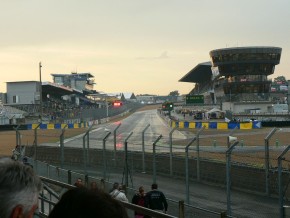
Race history
1923.-1939.
The 24 Hours of Le Mans race was first held on May 26 and 27, 1923, on a network of public roads around Le Mans. It was originally planned to be a three-year event with the awarding of the Rudge-Whitworth Triennial Cup to the winner who would drive the vehicle that would cover the longest distance of three consecutive 24-hour races. This idea was abandoned in 1928, and the overall winners were announced each year, depending on the distance they covered after 24 hours. The first races were dominated by French, British and Italian drivers, as well as the teams (cars) Bugatti, Bentley and Alfa Romeo of the then dominant brands. The winners of the first race were André Lagache and René Léonard from France, who drove the Chenard & Walcker Sport in 24 hours and covered 128 laps and covered 2.209,536 kilometers.
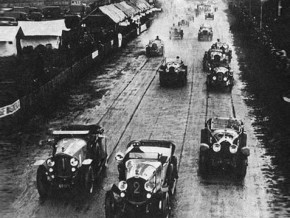
Innovations in car design began to emerge on the track in the late 1930s on Bugatti and Alfa Romeo models displaying highly aerodynamically made bodywork that would withstand high speeds in the Mulsanne direction. In 1936, the race was canceled due to a general strike in France, and then with the outbreak of World War II in late 1939 the race took a ten-year break.
1949.-1969.
Following the reconstruction of facilities and infrastructure around the track, the race was restarted in 1949 with renewed interest from major carmakers to participate in it. That year, Ferrari made their first victory in the general placement with the Ferrrari166MM, driven by Luigi Chinetti and Lord Selsdon.
After the formation of the World Sportscar Championship in 1953 of which Le Mans was part, manufacturers Ferrari, Aston Martin, Mercedes-Benz, Jaguar and many others began sending more cars to the race, supported by their factories for an overall win against their competitors. Their competition sometimes resulted in tragedy as in an accident during the June 11, 1955 race in which Pierre Levegh's Mercedes-Benz 300 SLR French car crashed out of the track, struck a crowd of spectators and killed 83 people.
The incident has led to the rapid comprehensive introduction of safety measures, not only on this track but elsewhere in the motorsport world. However, as safety standards improved, so did the speed of cars. The transition from an open racing roadster to a closed cockpit coupe resulted in speeds of over 320 kilometers per hour on the Mulsanne. Ford entered this story with its GT40, winning four consecutive victories before the late 1960s that substantially altered this race and cars.
Race cars of the time were mostly based on commercially produced models from the streets and roads, but by the late 1960s the production of such cars had come to an inevitable end.
1970.-1980.
At the beginning of the new decade, the race turned to even more extreme speeds and revolutionary car design. Extreme speeds changed the typical Le Mans start with the so-called. Rolling Indianapolis start. Although revamped serial cars continued to be driven, they were now in the lower classes, while purpose-built sports cars became standard.
The German Porsche 917, 935 and 936 has been dominant throughout the decade, but the collaboration of French manufacturers Matra-Simca and Renault brings the first victory to the hosts in 1950 with the Renault Alpine A442B. This decade has also been remembered for the excellent performances of many private designers and drivers, but with only two wins in the overall standings. Constructor John Wyer's Mirage model won in 1975, while owner Rondeau's Rondeau model won in 1980.
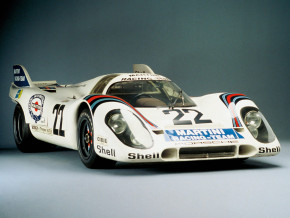
1981.-1993.
The rest of the 1980s was famous for the dominance of Porsche with the new so-called. Group C race cars that encourage fuel economy. Originally, it was a Model 956, which was later replaced by a Model 962. Both chassis of these models were affordable enough for the private masses to buy them, leading to the winning streak of these two Porsche chassis six years in a row. Jaguar and Mercedes-Benz are back in sports car racing again, with Jaguar first breaking the dominance of Porsche by winning the 1988 and 1990 models with the Jaguar XJR-9 and XJR-12 respectively. Mercedes-Benz wins in 1989 with a car that was the latest incarnation of the sleek Silver Arrows, the Sauber C9.
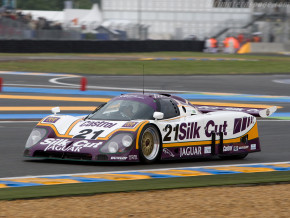
The advent of Japanese carmakers has led to prototypes from Nissan and Toyota. In 1989, the WM-Peugeot set a new speed record at 406 km / h on the part of the Ligne Droite des Hunaudières, known for its 6 km long course. Mazda is the only Japanese manufacturer to succeed in 787 with its unique rotary drive model, the Mazda 1991B.
The French Peugeot entered the race in 1992 and dominated the 1992 and 1993 races with the Peugeot 905, so vehicles from the Group C class and from the World Sportscar Championship slowly began to disappear from the standings in this race. The track will also undergo one of its most significant changes in 1990, when the 5 km long Mulsanne route was modified by setting two artificial barriers to reduce vehicle speeds of over 400 km / h then achieved.
This is the beginning of a trend initiated by the ACO in an attempt to slow down cars in various parts of the track, although speeds of over 320 km / h are regularly reached on different parts of the track in a single lap.
1994.-1999.
They saw the inevitable demise of the World Sportscar Championship at Le Mans as an ideal time to participate in serial versions of GT cars. Thanks to loopholes, Porsche was able to convince the ACO that the Dauer 962 Le Mans was a production car, thus allowing Porsche to compete with its Porsche 962 for the last time in the race. Although the ACO tried to close loopholes in the 1995 rules, the newcomer McLaren is winning the race with his McLaren F1 GTR supercar thanks to its design and reliability, winning faster and more prototype-prone problems.
That trend will continue through the 1990s with exotic supercars built to justify the new ACO rules regarding serial versions of race cars, leading to the entry of Porsche, Mercedes-Benz, Toyota, Nissan, Panoz and Lotus into the GT category . This culminated in 1999 when these GT cars collided with the Le Mans Prototype models of BMW, Audi and Ferrari.
German BMW wins race for the first time. The strong influence of the automaker is forcing the ACO to market the Le Mans sports car name in a 1999 series of similar races known as the American Le Mans Series, which continues to this day and serves to qualify teams to enter the Le Mans race.
2000.-2005.
Many major car manufacturers have withdrawn from sports car racing after 1999 because of the large costs that have been steadily rising. The others are so e.g. Cadillac and Audi easily dominated the race with their new Audi R8. Cadillac is out of the race after three years, with manufacturers Panoz, Chrysler and MG trying to beat Audi, but no one has matched the performance of the R8.
After three wins in a row, Audi provided the engine, team staff and drivers to its corporate partner Bentley, which returned to the race in 2001 so that the Bentley Speed 8 factory model was able to win the race in front of private Audi teams in 2003.
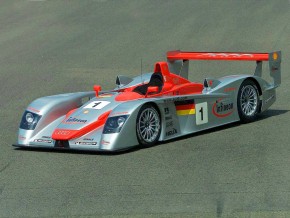
2006-present
Since the end of 2005, after five overall victories for the Audi R8 as well as six wins for its V8 turbo engine, Audi has taken on a new challenge by introducing a new prototype diesel engine known as the Audi R10 TDI. Although not the first diesel car in the race, it became the first diesel unit to win at Le Mans. This period saw other alternative fuel-powered models including bioethanol, and Peugeot decided to follow Audi's example and in 2007 appeared with the Peugeot 908 HDi FAP. 2008 saw an excellent racing duel between the Audi R10 TDI and Peugeot 908 HDi FAP. After 24 hours of racing, Audi was able to win with a difference of less than 10 minutes. For the 2009 race, Peugeot introduced a new KERS-like brake energy recovery system used in Formula One cars.
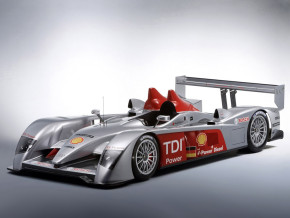
British Aston Martin entered the LMP1 category, but still participated in the GT1 class with private teams. Audi is back with the new Audi R15 TDI, but this time it beat Peugeot, winning its first overall victory since 1993. The next ACO supported series is also formed and is similar to the American Le Mans Series but is concentrated in Europe. The new Le Mans Endurance Series (later shortened to the Le Mans Series) resurrected many famous 1.000-kilometer endurance races, followed by the 2006 Japan Le Mans Challenge. Last year, Le Mans became the mainstay of the new Intercontinental Le Mans Cup, an attempt to recreate the World Endurance Championship. This year the race becomes the centerpiece of the FIA World Endurance Championship, the successor to the ILMC races. Since 2011, Porsche has become the most successful manufacturer with a record 16 wins including seven consecutive general placement wins.
Aerodynamics
Throughout its existence, Le Mans has seen many innovations in automotive design to counteract some of the difficulties caused by the track and race itself. They either dictated the rules or forced the carmakers to out-compete. One of the keys to success at Le Mans is controlling the maximum speed caused by the long routes that dominate the track. This means that the cars are trying to reach the maximum possible speed instead of having a strong downforce in the curves. While early competing cars were mass-produced passenger serial cars due to weight reduction, innovators like Bugatti developed cars that saw the beginning of aerodynamics. Nicknamed the tanks, because of their similarity to the fuel tank, these cars used simple chassis parts to cover all the mechanical parts of the vehicle with increasing speed. When the Le Mans competition resumed after World War II, most manufacturers made vehicles with closed cabs and bodywork that improved aerodynamics.
A significant example of the changes brought about by aerodynamics are the Briggs Cunningham vehicles from 1950. He appeared in a race with two Cadillac Coupe de Villes models. One was a production model, and the other was completely redesigned into a modernized vehicle with an aluminum body developed by aeronautical engineers from Grumman Aircraft Engineering Corporation. The aerodynamic car looked so unusual that it was nicknamed "Le Monstre" by the French press. Processing certain shapes and smoothing different parts of the car brings lasting improvements to reduce aerodynamic drag, and this has led to separation from the Grand Prix class of cars that rarely have an aerodynamic bodywork.
As the years went on, the body grew larger and lighter. The larger body was able to provide more so-called .Downforce thrust in bends without the ability to roll over, allowing vehicles to maintain high speed. Extended body parts are usually located at the back of the car called the Long Tail.
The body also begins to cover the cockpit of the car even though open cockpit models have been appearing and disappearing over the years as the rules have varied. Aerodynamics peaked in 1989 before the Mulsanne direction was altered.
During the 1988 race, the WM-Peugeot closed-circuit prototype crew achieved a record speed of 406 km / h along the Mulsanne direction, although the car was nearly impossible to drive anywhere else on the track and the engine was soon destroyed due to lack of cooling. However, in 1989, the Mercedes-Benz Sauber C9 reached a speed of 399 km / h under qualifying conditions.
engines
A wide range of engines in various cars competed at Le Mans in an effort to not only achieve higher speeds but also to achieve better fuel economy with the need to spend as little time in garages as possible. Engine size also varied greatly from the smallest engine of just 569 cc (Simca Cinq) to the largest ever in a race of 3 cc (Chrysler Viper GTS-R) volume.
The supercharging system was early introduced as an innovation to increase engine power and was first used in 1929 while turbo engines only appeared in 1974. The first non-piston-driven car appeared in 1963 when Rover teamed with the British Racing Motors team and a gas turbine-driven car achieved mixed success by repeating this in 1965. The American Howmet Corporation team will attempt to restart such a turbine drive in 1968 with even less success.
Although these engines offered great power, they were dangerously warm and fuel-efficient. The other non-piston engine to appear was the so-called. Wankel motor, also known as a rotary motor. Mazda introduced it in its cars in 1970, though this compact engine also suffers from fuel consumption problems.
After many years of development, Mazda finally succeeded in doing so, becoming the sole winner of the 1991 non-piston car race with its 787B.
Alternative fuels also play a big role in designing today's engines with the first non-gasoline engine to appear in 1949. The Delettrez Special model was powered by a diesel engine, while another diesel model, the MAP, appeared the following year. Although the diesel engine appeared in various cars during the existence of this race, it was virtually nonexistent until 2006, when, after investing in the development of diesel engines, the large German Audi manufacturer eventually managed to win the race with its Audi R10 TDI.
Ethanol as a fuel fuel appeared in 1980 in a modified model Porsche 911 who wins in his class. The drive for alternative biofuels resurfaced in 2004 with Team Nasamax and the DM139-Judd.
In 2008, the use of biofuels (with 10% ethanol for gasoline engines and biodiesel for diesel engines) was finally allowed. Audi is the first to use a new generation of fuel with 10% BTL biodiesel produced from biomass and developed by its partner, Shell.
From 2009 onwards Le Mans ACO new regulations allow the use of hybrid vehicles using the KERS / TERS (Kinetic / Thermal Energy Recovery System) system, but only for the storage of energy to be used as electricity (eg for batteries) for alternative drive.
Cars equipped with the KERS system appeared in the 2009 race with specific classification rules. Since 2010, they can compete to win points and titles.
Brakes
Increasing speeds on the track makes brakes a key issue for teams trying to get their cars safely at low speeds to take turns on curves like the Mulsanne Corner. Disc brakes were first seen on a 1953 Jaguar C-Type car driven at Le Mans. The Mercedes-Benz 300 SLR introduced the concept of air brake in 1955 using a large hood at the back of the car.
In 1980, the Anti-lock Braking System (ABS) became standard on most Class C cars as a safety measure, ensuring that cars did not lose control while still traveling at 320 km / h. By the late 1990s, reinforced carbon brakes had been modified to provide better stopping power and reliable car braking.
Successful manufacturers and drivers
In recent years, many automakers have been able to win the overall victory while many more have been winning singles by class. The most successful car brand to date in racing history is Porsche, which has won sixteen total victories including seven in the 1981-1987 series. Audi is next with ten, followed by Ferrari with nine, including six in a row from 1960 to 1965.
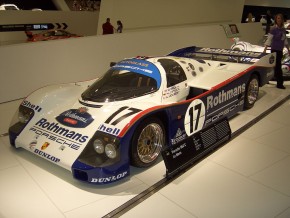
Until recently, the Audi brand has dominated the event, winning ten races out of the thirteen in which it participated. The Audi and Team Joest teams have two hat tricks in the 2000, 2001 and 2002 races. The Jaguar has seven wins while Bentley, Alfa Romeo and Ford have four wins in a row, but Bentley has two more wins in later years. The only Japanese brand to win the race so far is Mazda, although almost every major Japanese manufacturer has participated in the race. Mazda's 1991 victory is the only victory for a model with a rotary engine, one of the hallmarks of a Mazda car.
Two big drivers stand side by side in number of wins. Belgian Jacky Ickx held the record with six wins between 1969 and 1982, receiving the title of Honorary Citizen of Le Mans. However, Tom Kristensen of Denmark broke this record with eight wins between 1997 and 2008, including six in a row.
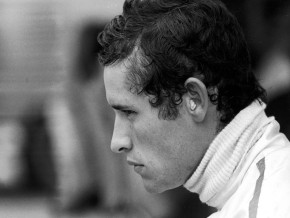
Accidents
In addition to the high speeds at Le Mans, the track saw a number of accidents, some of which were tragic for drivers and spectators alike. The most tragic moment in the history of Le Mans occurred in 1955 during a race in which more than 80 spectators and driver Pierre Levegh were killed. In the aftermath of this disaster, many major and minor races were canceled during that year, such as the Grand Prix races in Germany and Switzerland (the latter as a reaction had a ban on holding auto races across the country and the ban was lifted only in 2007 ).
This accident has contributed to the widespread and comprehensive application of safety regulations for all motor racing series for both drivers and spectators.
In 1986, Jo Gartner, while driving a Porsche 962C, hit a barrier on the Mulsanne Road and was immediately killed. His accident was the last fatal accident in the race itself, and the last accident with the same outcome was the death of Sebastien Enjolras in 1997 during training. In one of the most recognizable and unique accidents at Le Mans, a Mercedes-Benz car was again involved, thankfully without a tragic end.
The 1999 Mercedes-Benz CLR model was suffering from aerodynamic instabilities caused by the car itself when it stays out of contact with the ground at some point. Following the initial problematic event on Le Mans test day, Mercedes claimed to have resolved this problem without suspecting that it would reappear during the warm-up hours before the race.
Driver Mark Webber was that unlucky driver who happened to have his vehicle turned in both cases. The last and most serious accident that happened during the race itself was when Peter Dumbreck's Mercedes-Benz CLR driver swung in the air, then continued flying over safety fences and landed in the woods several hundred yards away. Neither of the two drivers was seriously injured in these three crashes, but Mercedes-Benz quickly withdrew its remaining cars from the race and completed its entire sports program.
In 2011, two of the three factory Audi TDI models in the LMP1 class were involved in two terrible accidents. Towards the end of the first race hour, Allan McNish's No. 3 car collided with one of the GT-class Ferrari causing McNish's Audi to smash against a tire firewall and be blown up at Dunlop Chicane. , resulting in Audi body parts flying all over and nearly hitting many photojournalists across the barrier.
In the eleventh hour of the race, another serious accident occurred when Mike Rockenfeller's No. 1 car also had contact with another Ferrari GT car. On the Indianapolis Corner portion of the lane, Audi's Rockenfeller burst out of the lane and hit safety barriers at 270 mph. Only the main cockpit, which is in fact a safety cell for the driver, remained whole with extensive damage to the car that needed to be repaired before the race resumed. No one was injured in these accidents despite having to chassis both chassis, which shows how much racing cars continue to thrive in safety and security over the years.
Media presence
Motors TV covered 24 Hours of Le Mans throughout 2006 and 2007. This included coverage of vehicle technical admission, qualifications, a driver parade, warm-ups and the entire race for a continuous 24 hours. In the United States, Speed Channel broadcasts full coverage of the race live or online through a combination of broadcasts from French TV broadcasters and live images of its own reporters from the race.
In 2008, Eurosport secured a multi-year contract for the transfer of the entire race including the qualifications and the 24 Hours of Le Mans motorcycle race. That year, every race hour was broadcast in segments on Eurosport and Eurosport 2 channels, but in recent years several race hours have been missed due to overlapping race times with other important sporting events. Additionally, Live Streaming video is available on the Eurosport website, but not for free. Since 2009, Eurosport and Eurosport 2 transmit this non-stop event with complete 24-hour coverage.
The race is also broadcast in English via Radio Le Mans. The broadcast from the reportage circuit lasts for 24 hours with pre-race and post-event footage and offers fans of the race the opportunity to listen to all comments via radio. Radio Le Mans also broadcasts this program via Internet radio on its website.
Retrieved from: www.netauto.rs
Recommendation of similar texts:

Hi there, I am Mladen and I am an auto enthusiast. I started this blog years ago to help like minded people share information about latest cars, car servicing ideas, used car info, exotic cars, and auto technology. You will find helpful articles and videos on a wide variety of cars - Audi, Mercedes, Toyota, Porsche, Volvo, BMW and much more. Ping us if you have anything cool to share on latest cars or on how to make older cars more efficient, or just want to say hi!

